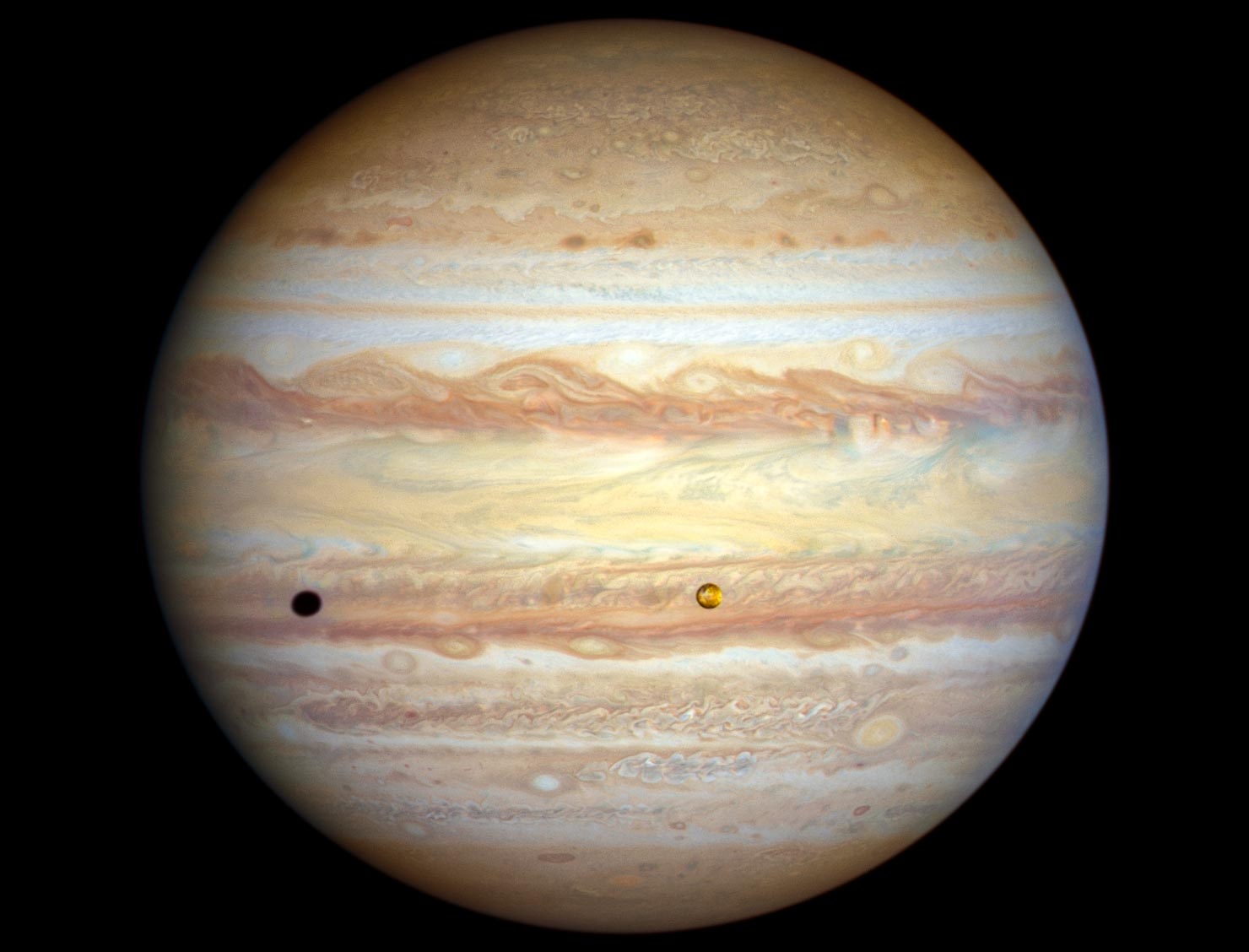
In this captivating image, Jupiter’s vibrant cloud tops are interrupted by orange moon Io, casting a shadow toward the planet’s western edge. Hubble’s remarkable resolution allows us to observe Io’s mottled-orange surface, which is attributed to its numerous active volcanoes. These fiery wonders were first revealed in 1979 during Voyager 1’s flyby. Beneath its thin crust, Io’s interior is engulfed by molten material ejected periodically through volcanoes. The varied color palette of Io’s surface arises from sulfur reacting to varying temperatures, resulting in a mesmerizing sight. Credit: Science: NASA, ESA, STScI, Amy Simon (NASA-GSFC), Michael H. Wong (UC Berkeley), Image Processing: Joseph DePasquale (STScI)
Forecast for hazy air, smog, etc
Outer planets beyond[{” attribute=””>Mars do not have solid surfaces to affect weather as on Earth. And, sunlight is much less able to drive atmospheric circulation. Nevertheless, these are ever-changing worlds. And Hubble – as interplanetary meteorologist – is keeping track, as it does every year. Jupiter’s weather is driven from inside-out as more heat percolates up from its interior than it receives from the Sun. This heat indirectly drives color change cycles highlighting a system of alternating cyclones and anticyclones. Uranus has seasons that pass by at a snail’s pace because it takes 84 years to complete one orbit about the Sun. The seasons are extreme because Uranus is tipped on its side. As summer approaches in the northern hemisphere, Hubble sees a growing polar cap of high-altitude photochemical haze that looks similar to the smog over cities on Earth.
Hubble Monitors Changing Weather and Seasons at Jupiter and Uranus
Ever since its launch in 1990, NASA’s Hubble Space Telescope has been an interplanetary weather observer, keeping an eye on the largely gaseous outer planets and their ever-changing atmospheres. NASA spacecraft missions to the outer planets have given us a close-up look at these atmospheres, but Hubble’s sharpness and sensitivity keeps an unblinking eye on a kaleidoscope of complex activities over time. In this way Hubble complements observations from other spacecraft such as Juno, currently orbiting Jupiter; the retired Cassini mission to Saturn, and the Voyager 1 and 2 probes, which collectively flew by all four giant planets between 1979 and 1989.
Inaugurated in 2014, the telescope’s Outer Planet Atmospheres Legacy (OPAL) Program has been providing us with yearly views of the giant planets. Here are some recent images:

Hubble Space Telescope images of Jupiter taken on November 12, 2022 (left) and January 6, 2023 (right). Credit: Science: NASA, ESA, STScI, Amy Simon (NASA-GSFC), Michael H. Wong (UC Berkeley), Image Processing: Joseph DePasquale (STScI)
Jupiter
[left]– The forecast for Thursday is for stormy weather in the low northern latitudes. A prominent string of alternating storms is visible, forming a “vortex street” as some planetary astronomers call it. It is a wave pattern of nested anticyclones and cyclones, locked together like a machine with alternating gears moving clockwise and counterclockwise. If the storms come close together, in the unlikely event of a merger, they could create an even larger storm that would rival the current size of the Great Red Spot. A staggered pattern of anticyclones and cyclones prevents individual storms from merging. Activity is also seen within these storms; In the 1990s Hubble saw no tornadoes or thunderstorm anticyclones, but these storms have sprung up in the past decade. Strong color differences indicate that Hubble is looking at different cloud heights and depths.
Orange moon Io photobombs this view of Jupiter’s multicolored clouds, casting a shadow toward the planet’s western flank. Hubble’s resolution is so sharp that it can see Io’s mottled-orange appearance associated with its many active volcanoes. These volcanoes were first discovered in 1979 by the Voyager 1 spacecraft. The moon’s molten interior is covered by a thin crust through which volcanoes spew material. Sulfur takes on different colors at different temperatures, which is why Io’s surface is so colorful. This picture was taken on November 12, 2022.
[right]—Jupiter’s famous Great Red Spot is central to this view. Although this vortex is large enough to swallow Earth, it has actually shrunk to a smaller extent than observed observations from 150 years ago. Jupiter’s icy moon Ganymede can be seen transiting the giant planet in the lower right. Slightly larger than Mercury, Ganymede is the largest moon in the Solar System. It is a cratered world with a predominantly water-ice surface with apparent glacial flows driven by internal heat. (Jupiter was 81,000 miles from Earth when the photo was taken, so this image is smaller). This picture was taken on January 6, 2023.

Hubble Space Telescope images of Uranus taken on November 9, 2014 (left) and November 9, 2022. Credit: Science: NASA, ESA, STScI, Amy Simon (NASA-GSFC), Michael H. Wong (UC Berkeley), Image Processing: Joseph DePasquale (STScI)
Uranus
Uranus, the odd ball of planets, does not spin vertically like Earth, but instead rolls on its side around the Sun as it follows an 84-year orbit. Uranus has a “horizontal” axis of rotation tilted at an angle of just eight degrees from the plane of the planet’s orbit. A recent theory proposes that Uranus once had a large moon that was gravitationally disrupted and then collided with it. Other possibilities include giant impacts during planet formation or giant planets exerting vibrational torques on each other over time. The effects of the planet’s tilt can last up to 42 years, leaving parts of a hemisphere completely without sunlight. When Voyager 2 visited in the 1980s, the planet’s south pole was pointed almost directly at the Sun. Hubble’s latest observation shows that the North Pole is now tilted toward the Sun.
[left]—This is a Hubble view of Uranus taken in 2014, seven years after the northern vernal equinox, when the Sun shone directly above the planet’s equator, and shows one of the first images from the OPAL project. Many storms with methane ice-crystal clouds appear in mid-northern latitudes above the planet’s cyan-colored lower atmosphere. Hubble took an edge-on image of the ring system In 2007, but this view sees the rings opening seven years later. At this time, the planet had many small storms and even some faint cloud bands.
[right]– As seen in 2022, Uranus’ north pole shows a thick photochemical haze, similar to smog over cities. Many small storms can be seen near the edge of the polar fog line. Hubble is monitoring the size and brightness of the North Pole cap, and it’s getting brighter every year. Astronomers extract several effects from atmospheric circulation, particle properties, and chemical processes that control how the atmospheric polar cap changes with the seasons. At the Uranian equinox in 2007, neither pole was particularly bright. The cap may grow even brighter as the northern summer solstice approaches in 2028, and it will be aimed directly at Earth, allowing good views of the rings and the North Pole; The ring structure then appears on the face. This picture was taken on November 9, 2022.
About Hubble
The Hubble Space Telescope represents a significant collaboration between NASA and ESA, with NASA’s Goddard Space Flight Center in Greenbelt, Maryland overseeing its management. Exploring the mysteries of space, the Space Telescope Science Institute (STScI) in Baltimore is leading Hubble’s scientific efforts. The Association of Universities for Astronomical Research, located in Washington, DC, operates STScI on behalf of NASA.





